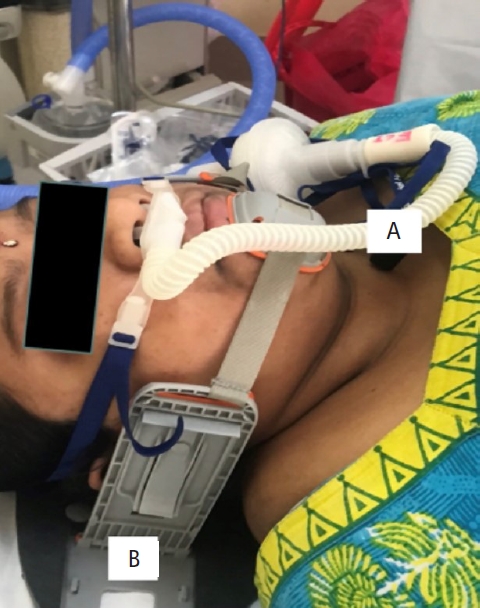 |
 |
| Korean J Anesthesiol > Volume 75(2); 2022 > Article |
|
The loss of upper airway tone is inevitable following the administration of intravenous anesthetic agents [1]. Hence, a manual jaw thrust maneuver has been vital for maintaining the upper airway patency. However, a jaw thrust device can alleviate the need for a manual jaw thrust maneuver thereby providing a hands-free technique during the conduct of electroconvulsive therapy (ECT).
The LUBO airway collar (Inovytech Medical Solutions, Israel) is a novel tool that has been recently used in trauma services to provide cervical spine immobilization. This airway collar has the advantage of simultaneously providing a jaw thrust maneuver and neck-free cervical spine control. The collar is simple to operate and consists of a mandibular arc, chin holder, and a gliding knob. Once placed, the gliding knob is pushed forward, thereby lifting the mandible, imitating a manual jaw thrust. The LUBO airway collar effectively maintains upper airway patency without oxygen desaturation following the administration of intravenous anesthetic agents [2]. The standard anesthetic technique for ECT involves bag and mask ventilation with manual jaw thrust following the administration of a short-acting intravenous anesthetic agent and a short-acting muscle relaxant. Applying a manual jaw thrust can be cumbersome for the attending anesthesiologist. Therefore, we have begun to use the LUBO airway collar along with trans-nasal humidified rapid insufflation ventilatory exchange (THRIVE) in the majority of patients who undergo ECT in our institution from the past six months. While awake, the LUBO collar is applied and the patients are pre-oxygenated with 30 L/min of high-flow nasal oxygen (Fig. 1). Subsequently, intravenous thiopental is administered, and the gliding knob is pushed forward. THRIVE flows are maintained between 50 and 70 L/min throughout the procedure. None of the 150 patients who have undergone this new technique experienced any desaturations.
Very limited evidence currently exists that describes the utility of the LUBO airway collar in anesthesia practice. This collar is very simple to use and can effectively maintain upper airway patency. THRIVE safely sustains apnea in short procedures like ECT by the provision of 100% oxygen along with dynamic positive airway pressure. Hence, the LUBO airway collar in conjunction with THRIVE effectively maintains upper airway patency in patients undergoing ECT, making it a total hands-free anesthetic technique.










